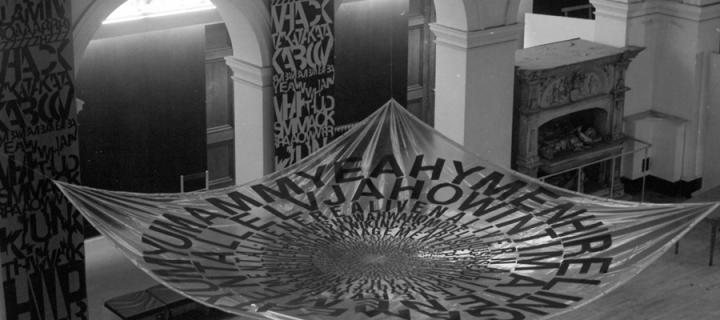9. Installation of visual text works by Ferdinand Kriwet in ECA's Sculpture Court
During Strategy: Get Arts, ECA’s impressive Sculpture Court was transformed by the installations and performances of several Düsseldorf-based artists, including Ferdinand Kriwet.

Ferdinand Kriwet
Ferdinand Kriwet (1942-2018) was born in Düsseldorf, an artist and experimental radio play author, who also developed theoretical manifestos on acoustic literature.
He was a pioneer in the field of multimedia art, who explored the impact of mass media representations of major historical events, analysing the language of advertising and television in the process.
Kriwet made a very considerable contribution to Strategy: Get Arts with a focus on visual texts:
- nine aluminium text signs,
- four poem-prints,
- six comic-strips (screenprints),
- a 40-metre long corridor text carpet entitled Walk Talk, Text-Dia,
- hanging text banners that cascaded down from the first to the ground floor of the Sculpture Court,
- the projector installation Apollo Amerika (requiring six Kodak carousel projectors and stereo equipment), a 16mm film entitled Apollovision,
- and more besides.
His distinctive typographical kaleidoscopic forms were ever-present throughout the exhibition.
Kriwet displayed various concentric text-signs. The circular use of text could be seen as relating to the geometric configuration of symbols of the mandala, spiritual guidance tools that can be seen in Hinduism, Buddhism, Jainism and Shintoism.
Examples from his series Text Dia (1970), rings of words printed on clear PVC sheets measuring over three-by-three metres, were also draped across the Sculpture Court.
Friedhelm Döhl
In addition, the Sculpture Court was used for the performances of Friedhelm Döhl (1936-2018), who collaborated with Günther Uecker (b. 1930) to create a ‘concert’ entitled Sound-Scene. Uecker installed a ‘cloth sculpture’ for this concert of electronic sound. It was a successful experiment and a Sound-Scene 2 was performed at the Nationalgalerie in Berlin in 1971.
The [Sound-Scene 1] concert was performed […] under an enormous white cloth, reminiscent of a great billowing sail, recalling images of the Flying Dutchman. The concert-goers stood or sat or lay recumbent on the wooden floor, most of them motionless under the mood of contemplation engendered by the music. When the synthesised music was seen to be synchronised in the intensity of the lights shining upon the white cloth (which at certain points came sloping down from the 40-foot high ceiling to within three or four feet from the floor), the experience of sculpture aspiring to the condition of music became positively tactile.
The Sculpture Court was also designated for performances by Franz Walther (b. 1939), who, like Beuys, wanted to really expand the concept of ‘art’.
Franz Walther
Walther was a student at the Kunstakademie Düsseldorf and studied there at the same time as Gerhard Richter, Sigmar Polke, and Gotthard Graubner.
Walther’s work was included in the pioneering exhibition, When Attitudes Become Form (Kunsthalle Bern, 1969) curated by Harald Szeemann.
For him [Walther] art is no longer something visual, material objects are only there to be used.

On 15 August 1970, Walther wrote to Demarco, unable to confirm when he was going to come to Edinburgh from New York, and that he had contacted the curator Jürgen Harten in Düsseldorf to suggest ‘somebody, familiar with my work, to demonstrate in my place.’ (See letter in Richard Demarco Archive, SNGMA).
C.W.


